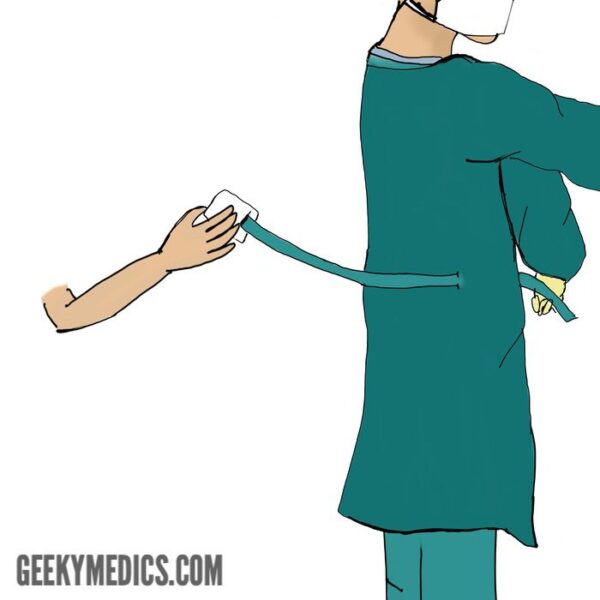- 📖 Geeky Medics OSCE Book
- ⚡ Geeky Medics Bundles
- ✨ 1300+ OSCE Stations
- ✅ OSCE Checklist PDF Booklet
- 🧠 UKMLA AKT Question Bank
- 💊 PSA Question Bank
- 💉 Clinical Skills App
- 🗂️ Flashcard Collections | OSCE, Medicine, Surgery, Anatomy
- 💬 SCA Cases for MRCGP
To be the first to know about our latest videos subscribe to our YouTube channel 🙌
This guide describes how to put on a sterile surgical gown in the operating theatre setting (often referred to as surgical gowning). As a result, this guide assumes you have already decontaminated your hands using an appropriate surgical scrubbing procedure.
Check out the Surgical Gowning Technique OSCE mark scheme here.
Check out the Surgical Gloving Technique guide here.
Check out our complete guide to Scrubbing, Gowning and Gloving here.
Surgical Gowning Steps
Picking up the gown
1. With one hand, pick up the entire folded gown from the wrapper by grasping the gown through all layers, being careful to touch only the inside top layer which is exposed.
2. Once your hands are securely pinching the gown in these slots, step back from the shelf and allow the gown to drop.
3. Make sure the gown does not touch any surrounding unsterile objects.
Inserting your arms into the sleeves of the gown
4. Grasp the inside shoulder seams and open the gown with the armholes facing you.
5. Carefully insert your arms part way into the gown one at a time, keeping hands at shoulder level away from the body.
6. Slide the arms further into the gown sleeves and when the fingertips are level with the proximal edge of the cuff, grasp the inside seam at the cuff hem using thumb and index finger. Be careful that no part of the hand protrudes from the sleeve cuff.
Fastening the gown
7. A theatre assistant will fasten the gown behind you, positioning it over the shoulders by grasping the inside surface of the gown at the shoulder seam. The theatre assistant’s hands should only ever be in contact with the inside surface of the gown.
8. The theatre assistant then prepares to secure the gown at the neck and upper back. Gowns differ in how they are secured, but most with have either ties, buttons or velcro tabs.

Next steps
The next step after gowning is to don some surgical sterile gloves.
If you’d like to learn more about this, you can check out our guide to surgical gloving or our comprehensive guide to scrubbing, gowning and gloving.
Final tie
As mentioned above, before the final tie is fastened, you need to don sterile gloves. This guide skips over the step to give you a focused overview of the various stages of gowning.
1. There is a cardboard slip holding two ties together across the front of the gown.
2. Detach the cardboard slip from the short tie, ensuring you keep hold of the short tie in your left hand.
3. Now pass the cardboard slip to the theatre assistant, ensuring not to make direct contact with their hand.
4. They will pass the tie around your back – now take the tie, and let them pull the cardboard off the tie so that you can tie a bow at your waist.
Illustrated by
Aisha Ali
Medical student and illustrator
References
1. National Institute for Health and Care Excellence 2008 Clinical Guideline 74 – Surgical Site Infection: Prevention and treatment of surgical site infection London, NICE
2. World Health Organisation 2009 WHO Guidelines on Hand Hygiene in Health Care (revised Aug 2009) [online] www.who.int/gpsc/en [Accessed August 2018]
3. The Association for Perioperative Practice. A guide to surgical hand antisepsis 2014. [Accessed August 2018]











